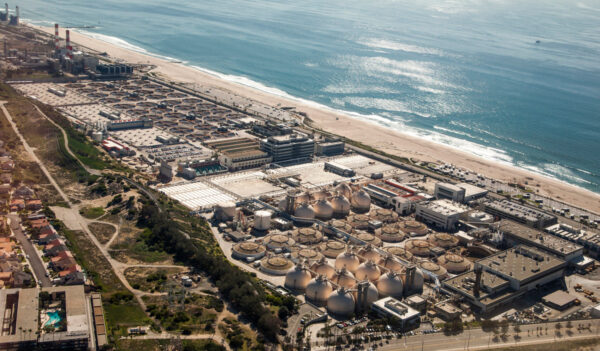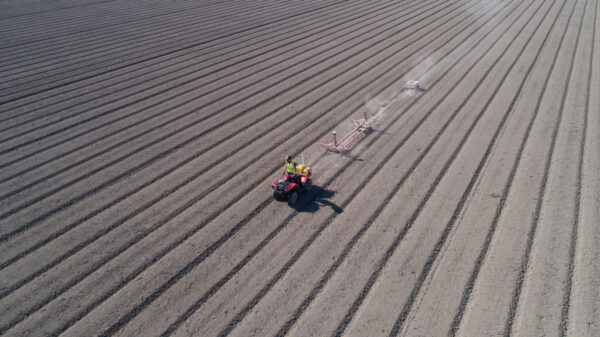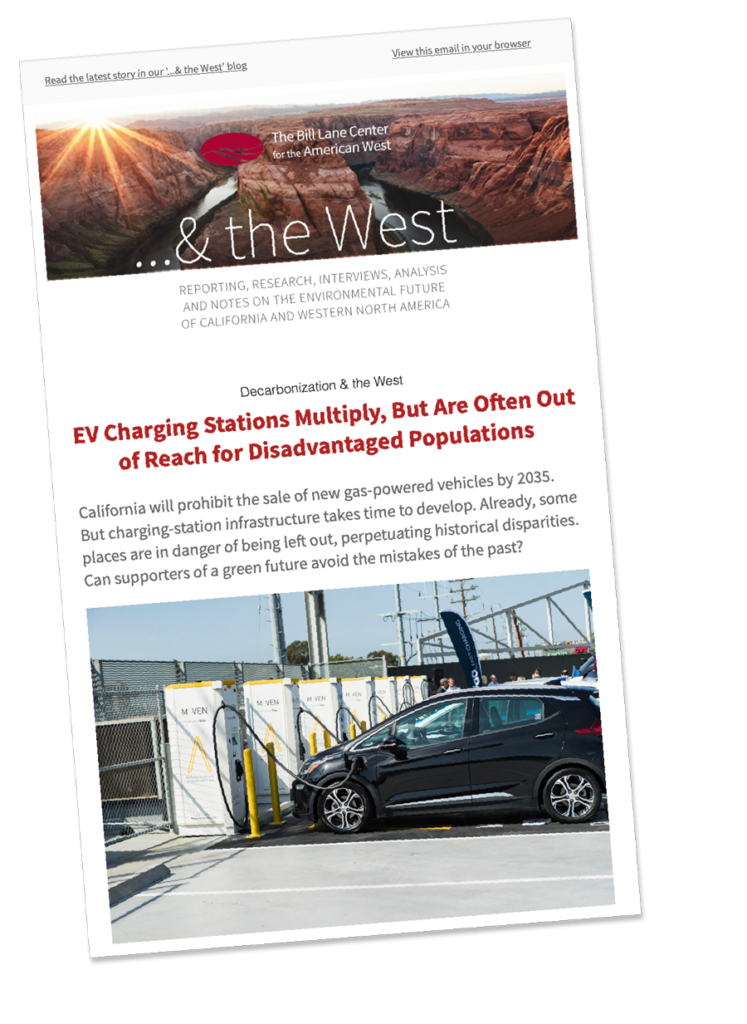Lowland agriculture in a changing climate A delta orchard seen in 2013. Chris Austin via Flickr
At the stroke of midnight, January 1st, 2023, the winds came.
Tom Slater, a wine grape grower near Clarksburg, California, was sitting in his house “when all heck broke loose for the whole state…” He continues, “I’ve never seen winds as bad as it was.” After a drought-stricken 2022, the New Year’s Eve storm of 2023 came out swinging, inundating the Sacramento-San Joaquin Delta with 10 to 15 inches of rain over two and a half weeks.
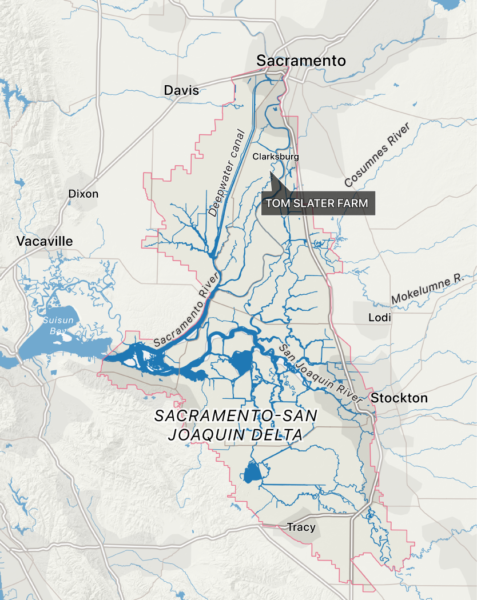
Along with the rain came gale force winds that knocked over trees and powerlines, leading to a weeks-long power outage. Luckily, Slater’s neighboring rivers, the Sacramento River and Elk Slough, were low, reducing the chance of flooding. But when the power went out, the electric pumps stopped. Normally, these were responsible for draining the fields in times of high water.
Though flooding wasn’t an immediate concern, it could have quickly become one as the storm rolled in. Stakes were high: for a large agricultural district like Tom’s located just miles from Sacramento, uncontrolled flooding could spell disaster for both farms and the city.
Storms like this one aren’t uncommon in the Sacramento-San Joaquin Delta, but 2023 was a unique year of “weather whiplash” for the region–a sharp transition from a drought year into the tenth wettest year on record. Those who make their living on the land are quickly learning to expect more such extremes.
Costly tunnel plan could alleviate flood risk, but divert water from delta farms
In anticipation of the effects of a changing climate on California’s water supply, the Department of Water Resources approved the Delta Conveyance Project on December 21, 2023. The plan, known colloquially as the Delta Tunnel, will move water from the Sacramento River at the north end of the Delta directly into pumps in the south Delta, bypassing the rest of the region. It will cost tens of billions of dollars and is immensely controversial because of its environmental impact and uneven effects on California farmers, who are already facing water-related challenges and a volatile climate. So far, eight lawsuits have been filed against DWR for its decision.
“We’ve had three flood years and we’ve had seven drought years. So we don’t get the ‘normal’ year anymore.”
Don Cameron, Terranova Ranch
But even before the tunnel’s prospects got better, climate change was intensifying the schizophrenia of California weather. “[In] the last ten years we’ve had three flood years and we’ve had seven drought years. So we don’t get the ‘normal’ year anymore,” says Don Cameron, who has served as the general manager of Terranova Ranch in Fresno County since 1981. His concerns echo those of Delta farmers, some of whom see 2023’s storms as a harbinger of a changing climate.
As the winds and rain of the New Year’s eve storm hit, Slater and other farmers from Reclamation District #999–an agricultural zone managed by landowners and overseen by the state government–brought in two massive generators to keep the pumps working. The generators ran constantly for three weeks before the power came back on.
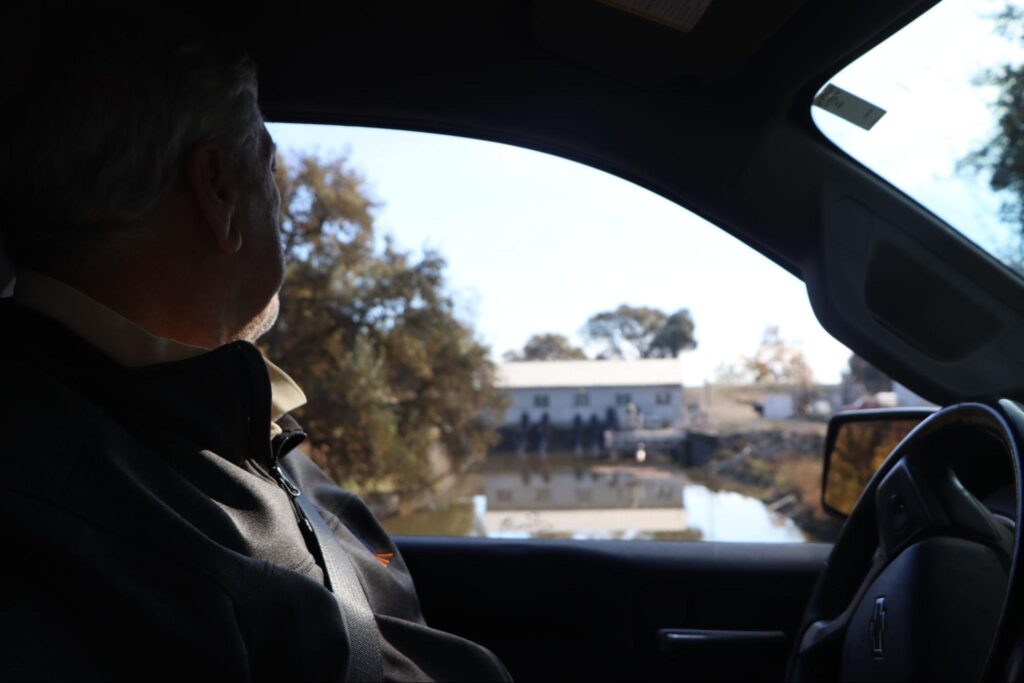
“If [we] didn’t have those generators, when we say we’d have flooded, it wouldn’t be from a breach of the levee. It [would’ve been from] too much water coming up…most of the homes are below sea level [so] they would have been underwater,” Slater reflects.
Understanding what nature will have in store for Delta farms is complicated because flood risk varies greatly with geography and infrastructure. Farms closer to large, dammed rivers like the Sacramento and San Joaquin tend to be safer in times of high flow. Those in proximity to smaller rivers without infrastructure, like the Cosumnes River east of Elk Grove, are at a much higher risk. But all Delta farmers–no matter where they grow–must think constantly about water because of the Delta’s unique geographical history.

An altered landscape
The Sacramento-San Joaquin Delta, or simply “The Delta” to those who live and work there, encompasses a complicated network of tidal rivers and streams that flow westward from the Sierra Nevadas to the San Francisco Bay, and northward into Sacramento and Solano Counties.
The Delta is part of the largest watershed in California, providing water to more than 25 million people and three million acres of farmland throughout the Bay Area, the San Joaquin Valley, and southern California. The region became an agricultural hub in the middle of the 19th century. It remains one, but today’s Delta looks nothing like it did 150 years ago. The reason: profound land use change.
During the Gold Rush of 1849, thousands of people flocked to the new city on the San Francisco Bay, bringing with them a massive demand for food, which farmers started to grow inland in the Delta and Central Valley. Today, corn, alfalfa, wheat, wine grapes, and tomatoes occupy the majority of the Delta’s 415,000 farmed acres, supporting the livelihoods of more than 23,000 people.
The wealth that agriculture brought to the Delta and the Central Valley came with a cost. As farmers drained and tilled their acres of nutrient-rich soil–a task they called ”reclaiming the land”–the soil oxidized and the land began to sink. Farmers built levees out of mounds of mud to prevent water on higher ground from flooding the lower agricultural areas, and the model stuck.
Delta farmland today is divided into parcels called “islands”, though they really function as inverse islands several meters below sea level, protected from floods by high levee barriers. Modern farmers rely on these levees now more than ever–they are sometimes the only thing standing in the way of their low-lying islands turning into crop-filled lakes. In 2023, a year of intense weather whiplash, island flooding was a particularly relevant concern.
2023: a very wet year
2023 was an exceptional one for precipitation precipitation in California. In the first quarter of the year alone, the state was slammed by 12 consecutive atmospheric rivers, strings of humid air that travel along the lower atmosphere, turning into rain or snow storms when their moisture cools, condenses, and falls.
For Slater and other Delta farmers, these atmospheric rivers meant relentless and intense wind and rainstorms for nearly three months straight.

The Delta rang in 2023 by breaking its 16-day precipitation record between December and January, and by April, snowpack size in the Sierras had skyrocketed to more than 200 percent of its average. All this water came both with benefits and at a great cost. While groundwater supply flourished throughout the state, back-to-back storms caused floods, power outages, landslides, and levee damage across the Delta.
Flooding is a familiar foe in this region–in the past, big floods washed through the Delta every five or six years–but also a devastating one. In 2023, the New Year’s flood tore a football field-sized gap in the Cosumnes River levee near Wilton, causing an estimated $1.5 million in damage. What the flood didn’t completely wash through, it severely damaged, necessitating months- to year-long repair efforts.
Flood preparation has been a way of life in the Delta for centuries, but the climate conditions of Northern California today are different than they were even a few decades ago. And while most Delta farmers are taking note, a changing climate means different things to different people.
Farming in a changing climate
“We can adapt to [climate change],” says Brett Baker, an attorney whose family has been farming pears in the north Delta for six generations. He and his colleagues believe the work they’ve done over decades to reinforce existing levees will be enough to stave off future floods. “We can make these repairs on a timescale,” he says. “We’re constantly improving the levees. It’s not like we won’t be able to continue to adapt to the extremes.” He continues, “as long as the land is profitable, we can maintain our levees.”
Others argue that the Delta’s susceptibility to floods can never be fully mitigated, even with reinforced infrastructure. “Climate change is working against [Delta levees] in multiple ways,” says Jeffrey Mount, a senior fellow at the Public Policy Institute of California’s Water Policy Center. “You have this increasing volatility in climate…floods are getting bigger…sea level is rising…and the land is lowering.” Mount says that any of these factors alone is bad news. All of them at once, a reality the Delta faces, could mean disaster.
An increasingly volatile climate has led some farmers to make strategic economic decisions. Daniel Wilson, a pear farmer near Walnut Grove in the north Delta, is one.

“The feeling is that over a 10 year period we're going to get the same amount of water that we've always gotten from rain,” says Wilson. “But…we're going to have longer periods of severe drought and shorter periods of some really severe rain…rather than getting a little bit of rain every year, we're going to get four years of no rain and then two years of just incredible amounts of rain.”
Wilson, a fifth generation farmer at Kay Dix inc., started working in the fields after he graduated college in 1977, returning to help his father get through a bad drought year. Now he’s more preoccupied with an overabundance of water than a lack of it.
“In my kids' and grandkids' lifetime, it may be very difficult to maintain the interior of the Delta.”
Daniel Wilson
Several years ago, Wilson traded farmland on Tyler Island, situated on the flood-prone Mokelumne River, for property on Grand Island, just across the Sacramento River. “We felt that the organic soils are being depleted and the islands are sinking, and the ocean is rising… in my kids' and grandkids' lifetime, it may be very difficult to maintain the interior of the Delta,” he says. This strategic move across the river likely saved Wilson hundreds of thousands, or even millions, of dollars in levee repair costs.
His other property, Deadhorse Island, just southeast of Walnut Grove, nearly flooded during the rains of 2023. Thanks to upstream levee modifications made after a flood in 1997, “[they] had a significant cushion.” But even though they held the water back, the levees protecting Dead Horse slipped during the deluge. “We didn't flood, but we did have a lot of damage which we just got done repairing [almost one year later],” he continues.
Delta farmers like Wilson have to be modern day Renaissance men: not just farmers, but also expert engineers, plumbers, and economists. When it comes to problem solving in the field, they are constantly thinking about water: how to test its quality, shuttle it from place to place, and, most urgently, mitigate the damage it can cause. Levees are essential to this effort.

When the levees fail
There are 1,100 levees in the Delta, spanning roughly 1,600 miles. Many have not been altered for more than a century. While the majority of the levees have stood the test of time, others–162 since the beginning of the 20th century–have failed during extreme weather events.
When Delta levees fail, more often than not, farmers bear the brunt of the damage.
“The levee systems that protect those farms are less robust than the ones that protect cities… When a levee breaks out on a farm, it's unpleasant. When a levee breaks in the city, people die,” says Mount. “The role of…[Delta] farms is, basically, taking water during flood events…”
A scenario like the one Mount describes is far from theoretical. The Jones Tract failure of 2004 flooded 12,000 acres of farmland and caused $100 million in damage, washing away dozens of houses and barns and incurring some farmers losses of upwards of $500,000. The farmland inundated by the levee breach remained covered by water for months afterwards, derailing crop harvests.
You could tell stories like these about many Delta levees. They break, farms flood, and river levels lower, saving urban areas downriver. But there is also an obvious caveat here: where will the more frequent and intense floods of the future leave Delta farmers, whose land is their livelihood?

“A different Delta”
As the climate shifts, scientists predict that rainy years like 2023 will become more common, ushered in by longer, wider, and wetter atmospheric rivers. These “more [frequent and] intense winter storms are increasing pressure on built infrastructure systems,” says the Department of Water Resources.
In the Delta especially, the coming storm of climate change brings with it costly implications for flood prevention infrastructure. Atmospheric rivers present a challenge, along with snowpack melt, but sea level rise may be an even bigger threat. Rising ocean levels will put more pressure on Delta levees, which are already situated below sea level.
Higher tidal levels are already apparent in the Delta. “When I visited the upper southeast corner of Bacon Island [located in the eastern Delta] during mid-tidal conditions [in November 2023],” says Jay Ziegler, Delta Watermaster on the State Water Resources Control Board, “there were probably only 3.5 feet of head [water height] between the middle fork of the river and the top of the levee.” Seeing these conditions mid-tide was striking to Ziegler, who couldn’t help but imagine what the river might look like at high tide. “It really made me realize the fragility of the island, its inherent vulnerability.”
Low farmland in conjunction with aging infrastructure is a recipe for “a different Delta,” says Jeffrey Mount. “And aren't we ready for that? The answer is no…we're talking hundreds of millions of dollars just to fix [levees and other infrastructure]. And the value of the land is too low to justify spending that kind of money. What do you do? You start making lakes…you have a very different landscape in which there's a lot less farming in the Delta.”
Preparing for a wetter, warmer future
Models included in the 2022 Central Valley Flood Protection Plan predict that by 2072, peak flood flows in the Central Valley will increase five fold with climate change. Water from the Delta flows south into the Valley, so it’s likely that, given this prediction, peak flows in the Delta could be even higher.
With the challenges farmers now face to keep flooding at bay, higher flood flows will be devastating unless drastic changes are made. One solution is to move closer to more controlled rivers, as Wilson did when he observed the rapidly changing conditions of the central Delta. For some, however, that would entail abandoning hundreds of thousands of acres of permanent crops such as pear trees and wine grapes in favor of more flexible--and less valuable--crops like alfalfa and wheat.

The state government champions other plans to combat climate change. The Delta Conveyance Project, advocated by Governor Gavin Newsom and approved in December by the Department of Water Resources, was pitched as an effective way to deal with climate-driven changes in California’s water supply. Maintaining the Delta in its current state–as its farmers, conservation advocates, and other residents would prefer–would take billions of dollars, but rather than stick to the status quo, the administration wants to spend $16 billion on the Delta Tunnel, which will shuttle water from the Sacramento River in the north to pumps in the south Delta, bypassing the vast majority of the region, where most Delta farmers make their living.
The Department of Water Resources calls the project “an essential climate adaptation strategy, [protecting] against future water supply losses caused by climate change, sea level rise, and earthquakes.” Residents of the Delta, environmental groups, and Native tribes vehemently oppose the project, claiming it will remove some of the Delta farmers’ essential water supply, drastically decrease the quality of the water that remains, and damage the environment.
Delta farmers in particular have strong opinions about the Tunnel. For Daniel Wilson, who grew up next to the Delta Cross Channel, the site at which water from the Sacramento River is currently diverted south into the Mokelumne River, the “Tunnel controversy” literally hits close to home.
“You're never going to get this tunnel built in California,” Wilson says, “because everybody–forget us farmers in the Delta–[is upset]. Every environmental organization, every tribe is saying, wait a minute, you're killing the salmon…It's going to drag on. It'll be my grandkids' fight, in my opinion.” Comparing the Delta Conveyance Project to some of California’s other large infrastructure undertakings, like the Bay Bridge and BART, Wilson argues that the Tunnel would also take multiple decades to build, even if it had the full support of all Californians.
Tom Slater echoes Wilson’s practical concerns about construction, noting that building anything underground in the Delta will be challenging because of its shallow water table, which is so close to the surface of the soil, Slater says, “I could take a shovel out [to the field] and hit water.”

The fight over the tunnels is often cast as a battle over water between Delta farmers and their drought-stricken counterparts in the Central Valley. The fact that the government is now recasting it as a way to mitigate climate change could reflect a growing realization among experts that the Delta–and the whole of California, as a result–has more to fear from the future than some of its farmers acknowledge. Or it may just be clever bureaucratic marketing.
Regardless, a real choice faces the current generation of farmers who have planted themselves and their livelihoods in the sinking Delta islands: stay where they are and continue to spend millions to adapt in the face of climate uncertainty, or relocate to less flood-prone regions of the Delta. To farmers’ chagrin, much of this decision rides on flood-prevention support from the state.
“I think with enough money, you can sustain [the Delta as is],” says Wilson. “Whether there will be enough money in the Delta to sustain that, that’s a political discussion.”
Edited by Felicity Barringer.


